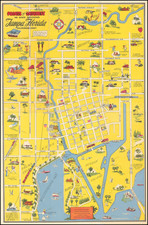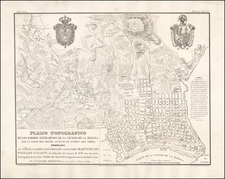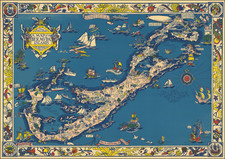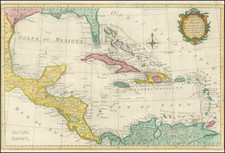Promoting United Fruit's Banana Monopoly
Rare Wall Map / Pictorial Chart illustrating the cultivation, harvesting, transportation, ripening and distribution of Bananas by the Fruit Dispatch Company.
The primary map illustrates the distribution routes serviced by the Fruit Dispatch Company, a subsidiary of United Fruit Company, with routes leaving for the United States from Santa Marta (Colombia), Colon (Panama), Bocas del Toro (Panama), Port Limon (Costa Rica), Puerto Barios (Guatemala), Belize, Frontera (Mexico) and Kingston (Jamaica). Fruit Dispatch was responsible for national advertising and promotional efforts of United Fruit, in addition to transportation logistics. In 1929, Fruit Dispatch hired consultants to engage in scientific market research, who recommended a shift from "low cost, tropical origin" advertising campaigns to campaigns focused on the middle class, "with emphasis on style, quality and health benefits of eating bananas."
The map also illustrates other products coming from these regions, including Hemp, Sugar, Tobacco, Coffee, Dye Woods, Timber, Cattle, Mahogany, Cacao, Oil, Citrus Fruits and Cattle Hides.
Fruit Dispatch Company was a subsidiary of United Fruit Company, which was established in 1870 to import Bananas to the United States from Jamaica.
United Fruit needed to assure a steady output of bananas to its consumer market in the United States. This was a difficult task because of the very nature of bananas, which rot quickly and easily. Given that they could not be produced in the consumer markets, the company developed an impressive production and distribution network between the tropical Caribbean and the United States that included plantations (with health and housing infrastructures), railways, ports, telegraph lines, and steamships.
In 1900 United Fruit owned 212,394 acres of land. By 1954, it owned 603,111 acres scattered in Central America and the Caribbean. The company also established the Fruit Dispatch Company, a subsidiary in charge of distributing bananas in the United States. United Fruit was a major shareholder of the Hamburg Line, a German shipping company, and also bought 85 percent of the shares of the British banana import and shipping company Elders and Fyffes, assuring United Fruit a privileged position in the British market.
In 1913 the company also created the Tropical Radio and Telegraph Company to keep in constant communication with its ships and plantations. Additionally, the Great White Fleet developed a refrigeration technology that facilitated the long-distance transportation of the fruit. Finally, United Fruit quickly eliminated its smaller competitors such as the Atlantic Fruit Company and Cuyamel Fruit Company.
Rarity
We find no records of any surviving examples of the map.
The bananamuseum.com website illustrates a fragment of the poster (bottom center merchant illustration).










![[Soviet Union] Our Country -- From Wooden Plough To Sputnick](https://storage.googleapis.com/raremaps/img/small/47092.jpg)



